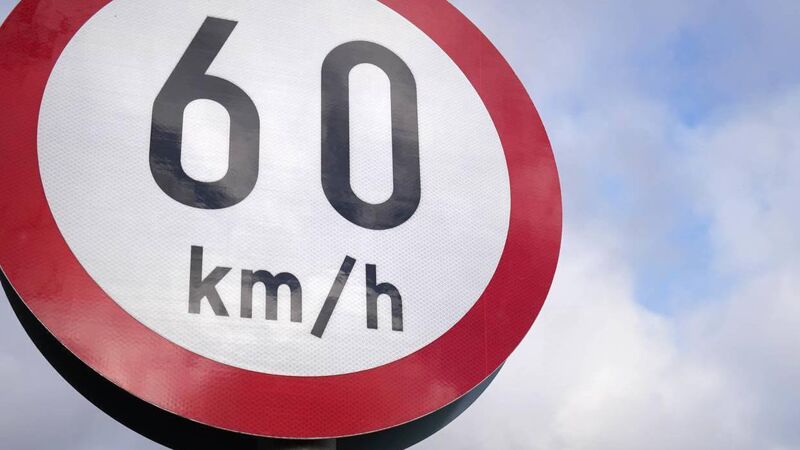Áilín Quinlan: New speed limits, you say? Will someone tell the drivers that...

I was out walking, early one weekday morning more than a fortnight after the widely publicised announcement of new and forthcoming traffic speed limits.
My walk took me through what is officially designated as an ‘urban core’. I was walking along a footpath through two adjoining, heavily built-up communities.
The speed limit for these roads is set to be reduced from 50km/h to 30km/h later this year.
Both sides of the road featured traditional ribbon-development housing whose front doors or garden entrances opened onto the pavements. There was also a church and a school and a shop and a post office.
Now, despite the fact that this was very obviously a built-up residential area, and despite the fact that there was a clearly signposted 50km/h speed restriction as well as electronic signage flashing information about what speed vehicles were travelling at, a cascade of lorries, SUVs, cars and other vehicles were barrelling through at speeds that were flagrantly in breach of the limit.
It was still quite early, though, and not many people were around. Maybe the drivers were just rushing to work, I thought, trying my best to be tolerant.
A few days later, I walked through the same area in the afternoon, interested to see if drivers obeyed the 50km/h speed limit when the area was awake and when there were more actual humans around – pedestrians, schoolchildren, shoppers, and so on.
I took the same route precisely as pupils were released from the local primary school at the end of the school day.
Despite the fact that large numbers of young children were visibly pouring out of the school gates, despite the fact that the area was busy with parents and children crossing roads, walking footpaths, cycling bikes, and getting into parked cars, most of the drivers flew at high speed through this busy neighbourhood much as if they were on a motorway.
I didn’t have a mobile speed-measuring device in my hand, but the speed of so many of those vehicles was, in my humble estimation and that of another pedestrian who also happened to be observing, shamelessly in breach of that 50km/h restriction.
I was particularly horrified by the speed of one driver, whose lorry bore the easily identifiable colour and branding of a well-known firm. I took out my phone and pointed it at his vehicle as it passed by.
He saw me and leaned out of his window as he flew past, gesticulating aggressively – he may have thought I was either snapping his registration number or pointing an amateur speed-gun of some kind in his direction, and he was furious.
The thing is, if most drivers won’t obey the existing 50km/h restriction in built-up areas, can we really expect that they’ll comply when the speed limit drops to an even more inconvenient 30km/h later this year?
Because who will be mounting surveillance around these ‘urban centres’ to catch the drivers who don’t comply when the new speed limit of 30km/h comes into force?
Where, I wondered, are the gardaí in all of this?
Maybe I’m missing something, but I haven’t seen any traffic patrols in our area since February 7, when the first set of new speed limits of 60km/h - down from 80km/h - went into operation on the network of small rural roads near where I live.
All I see is drivers continuing to travel at the same aggressive high speed they did before the new limits went into operation.
Drivers are still belting along through the outskirts and into the heart of my local ‘urban core’ - just as they always did.
They are neither complying with the new 60km/h speed limit on the small rural roads, nor with the existing 50km/h in residential neighbourhoods.
And yet, according to the Road Safety Authority, 60% of motorists consider rural local roads to be unsafe, and more than 60% are in favour of reducing speed limits on rural local roads – because, it’s felt, most motorists drive too fast on roads which often feature sharp bends.
The Road Safety Authority has repeatedly pointed to the clear scientific evidence showing that speed levels are directly linked to the likelihood and the severity of collisions.
First, lower speeds give the driver more time to react to an unexpected issue and reduce the chance of a collision.
Secondly, lower speeds significantly reduce the severity of the potential injury to everyone involved.
And thirdly, pedestrian survival rates improve dramatically with lower speed - at 80-90 km/h, nine out of 10 pedestrians will be killed if struck by a vehicle. This drops to five in 10 at 60km/h.
And yet you have these morons racing through rural communities just as young children are being released from school?
Yes, we may have the shiny new speed limit signs up all over the place. But I ask again. Despairingly.
Where are the gardaí who are clearly so badly needed to enforce the new rules?







 App?
App?







